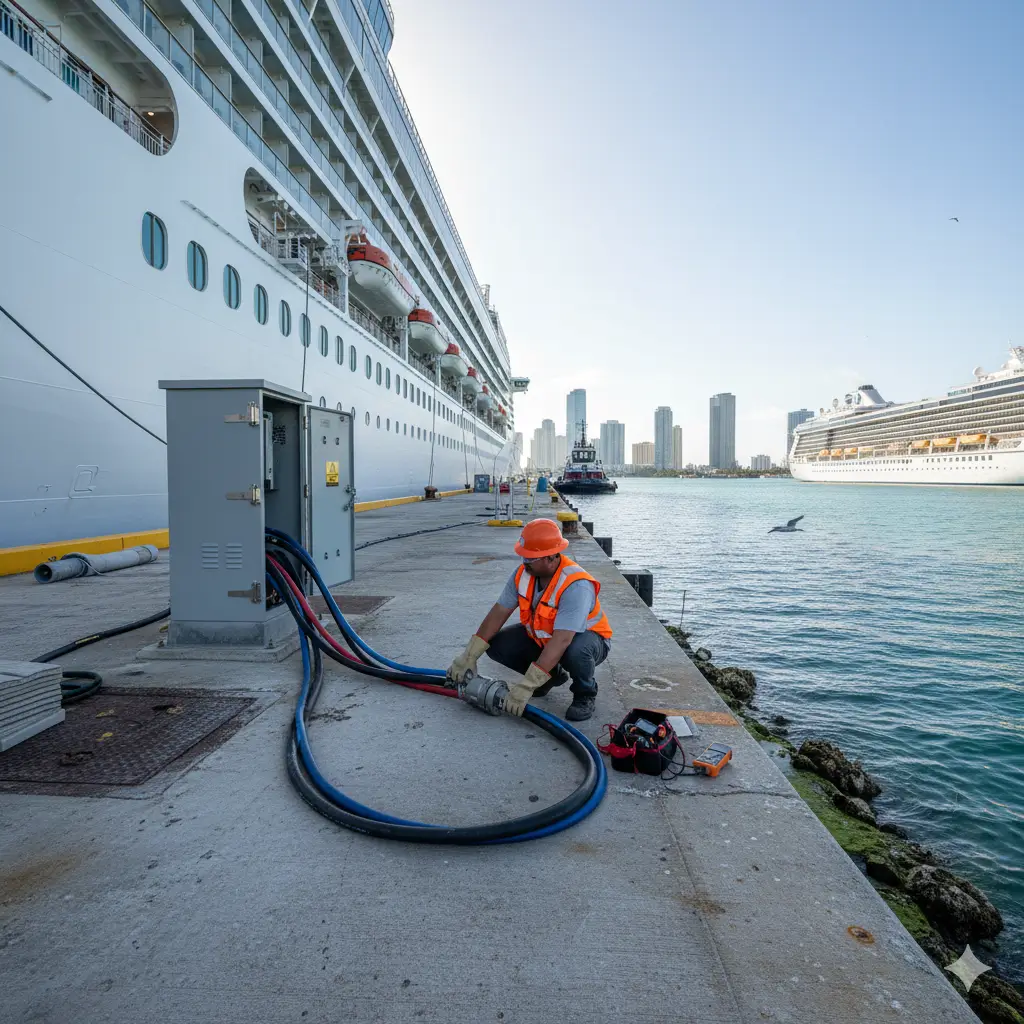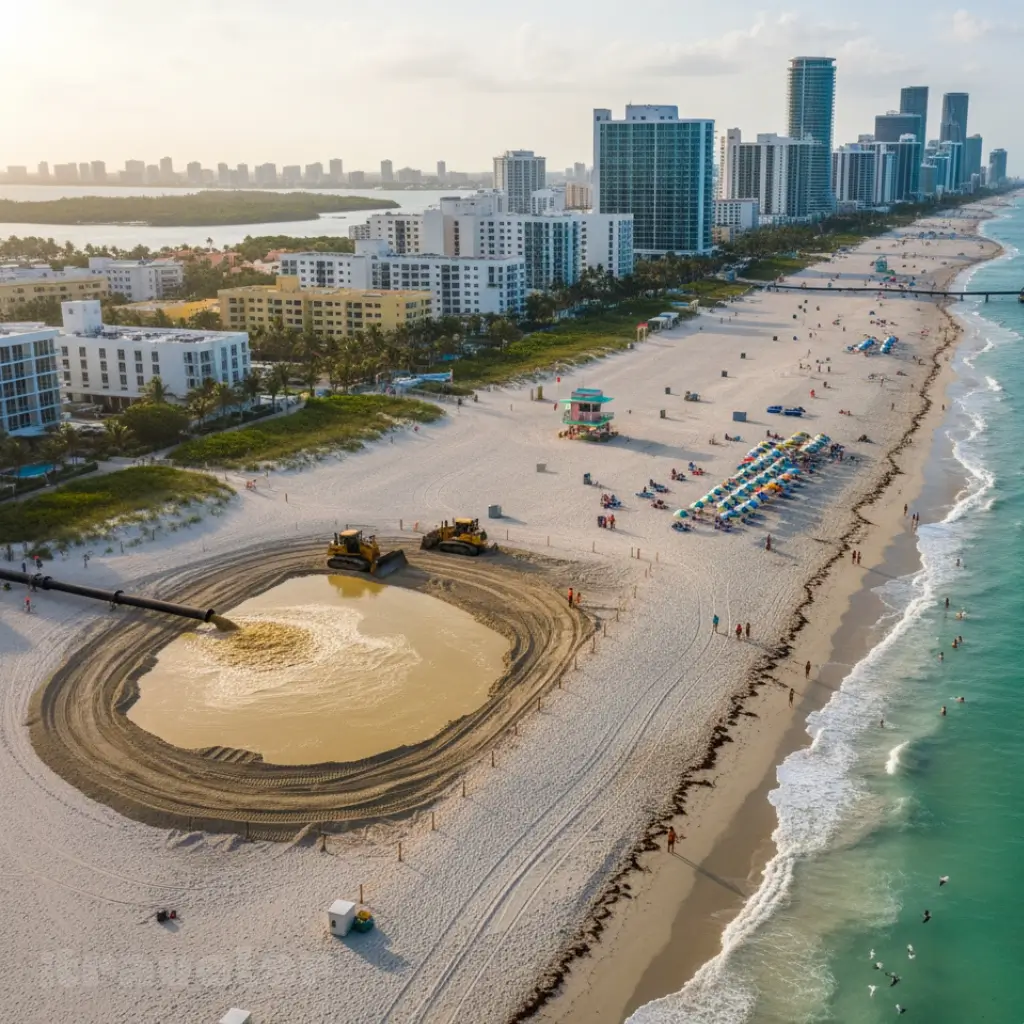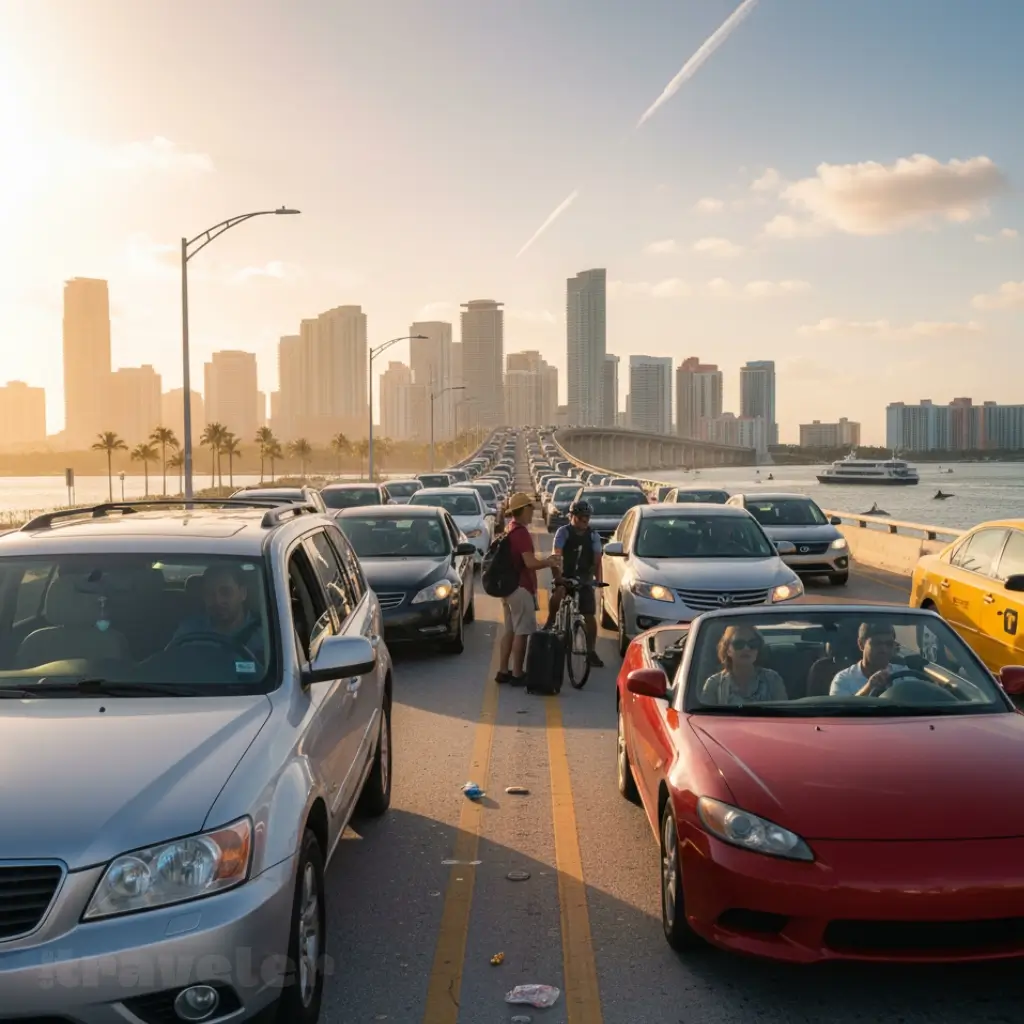Miami has long sold itself as a sun‑soaked paradise where visitors can escape to beaches, nightclubs and waterfront resorts. Its tourism economy is enormous. Miami‑Dade County hosted more than 28 million visitors in 2024, with hotel occupancy hovering around 82 % and new 800‑room hotels planned at the convention center. The crowds bring economic vitality, but they also strain coastal ecosystems, infrastructure and the region’s ability to cope with climate change.
This article examines the environmental costs of Miami’s tourism boom focusing on energy and water consumption in hotels and resorts, the air and sea impacts of cruise ships, beach erosion and coastal management, traffic congestion, and the sustainability efforts attempting to mitigate these pressures.
Jump to: Energy & Water Use • Cruise Tourism Impact • Beach Erosion & Management • Traffic & Emissions • Sustainability Efforts • Conclusion • FAQ
TL;DR - The Environmental Costs of Miami Tourism
- Hotels: heavy energy and water use; 1 Hotel South Beach shows how data tracking and smart systems cut waste.
- Cruise ships: 1 700 annual visits emit CO₂ equal to 7 000 homes; shore-power plan promises 35 % cut once built.
- Beaches: 7 m annual visitors, $200 m+ spent to fight erosion, 750 000 m³ of sand replaced yearly.
- Traffic: 70 m+ annual visitors push Miami into top-5 U.S. cities for congestion and emissions.
- Hope: LEED hotels, solar panels, EV chargers, and shoreline restoration point to a cleaner future.
More on Miami:
Energy and Water Consumption in Hotels and Resorts

Hotels and resorts are among tourism’s most visible symbols, and they are voracious consumers of energy and water. A report in Sustainable Business Magazine notes that energy is one of the largest controllable expenses for U.S. hotels. Properties historically relied on simple measures—swapping incandescent bulbs for LEDs or reusing linens—but many now install building‑management systems and benchmark their performance using metrics like kilowatt‑hours per square metre and litres per guest‑night.
Data‑driven benchmarking is crucial to avoid greenwashing and track progress. Miami’s hotel occupancy rebounded strongly after the pandemic, and with higher occupancy came higher energy and water consumption.
One sustainability leader is 1 Hotel South Beach, a 426‑room property built into a former 1970s condominium. The hotel is LEED Silver–certified and uses energy‑efficient heating and cooling systems, occupancy‑sensing thermostats and solar panels on beachfront tiki huts. Intelligent lighting controls and a building management system help the hotel optimise electricity use, and a 12 000‑plant living wall provides natural insulation while absorbing carbon dioxide.
Data collection is central; the hotel tracks carbon emissions, energy consumption, water stewardship and waste diversion to understand how each guest’s stay affects its footprint. The resort also offers electric house cars and encourages guests to walk or use public transit.
Other Miami hotels have embraced technology to lower energy consumption. In 2022, Loews Miami Beach Hotel replaced three large boilers and 1 200 gallons of stored hot water with an on‑demand hot‑water system. The new system heats water only when needed, eliminating the energy cost of keeping large tanks hot around the clock. According to Intellihot, the system’s manufacturer, this not only reduces water use but also delivers hot water faster and more efficiently. Such upgrades illustrate how hotels can reduce their climate impact while saving money.
Water use is another critical issue in a region increasingly vulnerable to drought and saltwater intrusion. Hotels typically consume far more water per guest than residents. A benchmarking program in the European hospitality industry found that hotels use roughly 300 litres of water per guest per night, while participants in a water‑saving initiative reduced usage to 167.88 litres per guest night—still higher than the 144 litres a typical resident uses in a whole day.
Miami hotels have begun adopting low‑flow fixtures, smart irrigation systems that adjust based on weather data, and centralised water filtration stations that encourage guests to refill bottles rather than purchase single‑use plastic. 1 Hotel’s pools use ozone and chlorination systems to reduce chemical consumption, and its landscaping is watered with high‑efficiency drip irrigation. These measures show that meaningful reductions are possible when consumption is tracked and managers prioritise efficiency.
Impact of Cruise Tourism on Air and Sea Quality

PortMiami markets itself as the “Cruise Capital of the World,” and cruise ships are central to Miami’s tourism image. Yet the environmental impact of these floating cities is staggering. Heavy fuel oil, the bunker fuel that powers most cruise ships, is among the dirtiest fuels in use; each day at sea a cruise ship can emit more sulphuric gas than 13 million cars and more soot than one million cars. Even when docked, cruise ships must run their engines to power lights, kitchens and air conditioning.
A single ship in PortMiami emits about 48 metric tons of greenhouse gases during a 10‑hour visit, equivalent to the annual emissions of five houses. In a typical year before the pandemic, cruise ships at the port emitted greenhouse gases comparable to the annual emissions of nearly 7 000 homes.
These emissions have tangible health and climate impacts. Ships idling in port spew particulate matter and nitrogen oxides that contribute to respiratory problems and degrade air quality. PortMiami sees about 1 700 cruise ship visits annually, with each requiring as much as 10 megawatts of power while in port. The port has discussed shore power—allowing ships to plug into the local electric grid instead of burning fuel while docked—for more than a decade.
A Miami Herald investigation revealed that installing shore‑power infrastructure could reduce carbon emissions at PortMiami by about 35 % and cut sulphur oxide emissions by 67 % and nitrogen oxides by 99 %, yet no system was implemented. County officials invested hundreds of millions in new cruise terminals but deferred the roughly $20 million per berth needed for shore power.
Other ports illustrate the scale of the problem. An emissions inventory at Broward County’s Port Everglades found that cruise ships—only 22 % of ship calls—produced 55 258 metric tons of carbon in 2015, more than all other ships combined. Critics argue that cruise companies externalise environmental costs onto local communities while promoting a luxurious escape on board. Some cruise lines have started equipping new vessels with shore‑power capability, but retrofitting older ships is expensive—up to $2 million per vessel—and port infrastructure can cost several million dollars per berth.
PortMiami recently announced plans to construct the largest shore‑power project on the U.S. east coast and a net‑zero‑carbon cargo supply chain, but these facilities are still years from completion. Until then, ship exhaust will remain a major contributor to Miami’s air pollution and greenhouse gas inventory.
Beach Erosion and Coastal Management

Tourists are drawn to Miami’s white sand beaches, but those beaches are constantly eroding and expensive to maintain. Miami Beach is a barrier island with more than seven miles of public beaches that attract approximately seven million overnight visitors each year and generate $11.4 billion in visitor spending. These beaches also protect an estimated $46 billion in property from storm surges. To keep the sand in place, the City of Miami Beach and Miami‑Dade County spend millions of dollars annually on maintenance—about $212 million from the city and $2 million from the county.
Daily tasks include sifting sand, cleaning litter, maintaining dunes and repairing boardwalks. Walking along South Beach on a summer afternoon, one can easily see crews raking debris, while throngs of visitors set up umbrellas cheek to jowl.
Beach erosion in Miami is not a natural process alone; past engineering projects disrupted sediment flows. By the 1950s, channels, groynes, dredging and seawalls had accelerated erosion along Miami Beach and threatened tourism. To save the city’s lifeline, the U.S. Army Corps of Engineers undertook one of the world’s largest beach nourishment projects in the 1970s and 1980s—pumping over 18 million cubic metres of sand onto an 18 km stretch of coast to create a beach 200 m wide.
Because waves and storms continually carry sand away, roughly 750 000 cubic metres must be replenished each year. This ongoing nourishment is costly, and dredging sand from offshore “borrow” sites can damage marine habitats, including seagrass beds and coral.
Local governments recognise that beach renourishment is not a permanent solution. In 2023, the City of Miami Beach and the South Florida Mayor’s Beach Alliance began exploring a regional resiliency plan to address climate change, rising seas and increased storm intensity. The Alliance works with the U.S. Army Corps of Engineers to identify offshore sand sources and ensure that borrowed sand matches the grain size and ecological characteristics of native beaches. The plan includes testing and approving sand sources and exploring “sand bypassing” systems that move sediment around inlets.
Maintaining the beaches may cost hundreds of millions of dollars, raising questions about who should pay and whether the strategy is sustainable as sea levels rise. For now, Miami’s beaches remain artificially maintained playgrounds that illustrate the tension between tourism and coastal ecology.
Traffic Congestion and Emissions from Tourism

Beyond its beaches, Miami’s allure lies in its nightlife, art deco architecture and year‑round warm weather. This popularity brings millions of visitors who mostly rely on cars. Miami ranks among the most congested cities in the United States—5th worst nationally and 9th worldwide—and traffic increased 30 % between 2021 and 2022. Visitors add significantly to the vehicle count: in just three months of 2023 (April–June), 33.1 million in‑state visitors and 1.9 million international tourists passed through Miami, contributing to an estimated 70.8 million annual visitors.
The city’s 2013 air‑quality report concluded that motor vehicles accounted for most of the county’s air pollution and that vehicle growth outpaced population growth. Globally, tourism already generates about 11 % of greenhouse gas emissions and is expected to double by 2050.
Traffic has social as well as environmental costs. Miami‑Dade’s average commuter loses more than 100 hours annually to congestion, costing roughly $4 billion in lost economic output. The gridlock is palpable on Biscayne Boulevard or along the causeways connecting Miami Beach to the mainland, where lines of cars creep forward under the hot sun. During spring break 2023, crowds and traffic became so unmanageable that officials imposed curfews and closed beaches to reduce chaos and allow emergency vehicles to move. Many residents complain of trash left behind by visitors and cultural commodification of their communities.
Meanwhile Miami International Airport continues to expand, welcoming 52 million passengers in 2023 and planning for 77 million by 2040; the $7 billion expansion aims to mitigate erosion and reduce energy use, but the airport’s electricity bill exceeds $2 million per month. These figures show how tourism compounds existing infrastructure challenges and highlights the need for public transit, ridesharing and sustainable transport options.
Sustainability Efforts and Hopeful Signs

Despite the challenges, Miami offers examples of how tourism could evolve toward a more sustainable model. Several hotels, led by 1 Hotel South Beach, are using data and design to shrink their footprints. The hotel’s transparency dashboard publicly reports real‑time data on energy and water use, encouraging guests to participate in conservation. Sensors measure waste to refine recycling and composting programs. Other hotels integrate renewable energy by purchasing Green‑e‑certified electricity and installing solar panels.
Behavioural design features—such as door‑card‑linked thermostats that shut off air conditioning when guests leave, EV charging stations, and transit information at check‑in—help guests reduce their impact. Meanwhile, Loews Hotel’s on‑demand water heating shows that simple technological swaps can yield significant energy and water savings.
On the maritime front, PortMiami has committed to building the eastern United States’ largest shore‑power project and a net‑zero‑carbon cargo supply chain. Although the implementation timeline remains uncertain, the project signals a shift toward recognizing cruise emissions as a serious problem. The port is also exploring an inland cargo depot to reduce truck traffic and associated emissions. Beach management plans include collaboration with the U.S. Army Corps of Engineers through the Mayor’s Beach Alliance to ensure that renourishment uses ecologically compatible sand and to develop regional strategies for climate resilience.
Over the long term, such collaborations could expand to incorporate nature‑based solutions like dune restoration and mangrove replanting, which both protect shorelines and sequester carbon. Policy discussions about funding also underscore the need for visitors to contribute to the costs of maintaining the very environment they enjoy.
Conclusion
Miami’s tourism economy thrives on the promise of sun, sea and celebration, but it also imposes substantial environmental costs. Hotels consume vast quantities of energy and water, though pioneering properties demonstrate that efficiency and transparency can reduce consumption. Cruise ships emit more pollutants per visit than many neighbourhoods generate in a year, and until shore‑power projects are built, local air quality will continue to suffer.
The region’s iconic beaches require continuous infusions of sand and millions of dollars in maintenance to combat erosion exacerbated by past engineering and rising seas. Traffic congestion and automobile‑driven emissions are already among the country’s worst, a problem magnified by tens of millions of visitors each year.
Balancing economic benefits with environmental stewardship will require bolder action from policymakers, businesses and travellers alike. Investments in renewable energy, public transit and shore‑power infrastructure can cut emissions; strict litter enforcement and visitor education can ease the burden on beaches; and transparent sustainability metrics can help consumers choose hotels that genuinely reduce their footprint.
Miami’s natural beauty is its greatest asset. Preserving it will determine whether the city remains a desirable destination in an increasingly climate‑changed world.
FAQ
Why is Miami’s tourism growth an environmental issue?
Hotels, cars, and cruise ships consume large amounts of energy and water, increase emissions, and stress beaches and wildlife.
How much water do hotels use compared with residents?
Hotels average about 300 L per guest per night, more than double the daily use of an average Miami resident.
Why are Miami’s beaches eroding?
Decades of dredging and seawalls disrupted natural sand flow; millions are spent annually on renourishment to protect property.
What’s being done to curb cruise-ship pollution?
PortMiami is building the East Coast’s largest shore-power system so ships can plug into clean electricity while docked.
Can Miami tourism become sustainable?
Yes. With energy-efficient hotels, EV charging, beach restoration, and transparent metrics showing real emission cuts.
